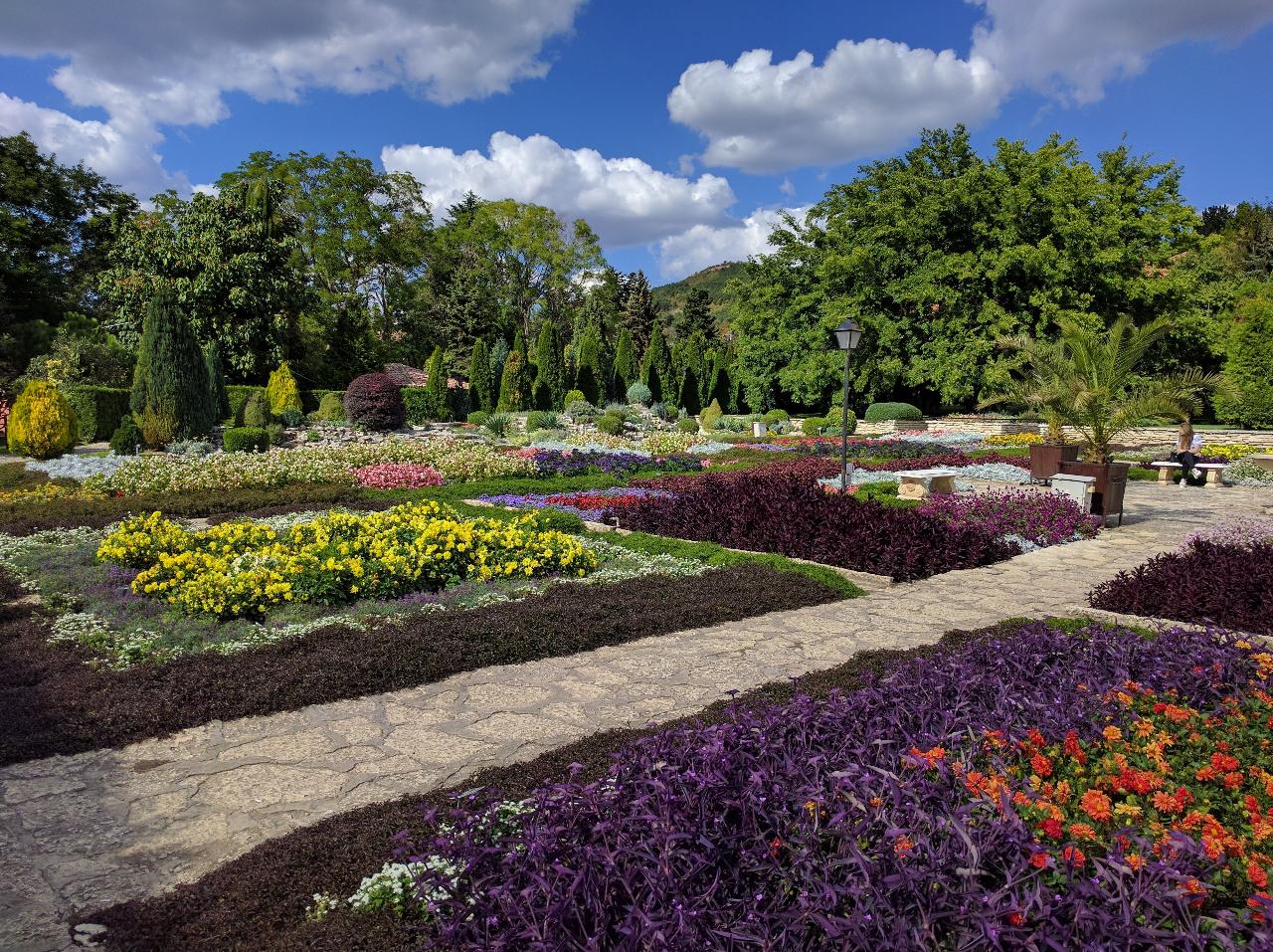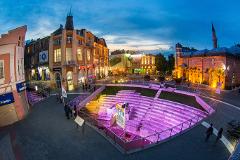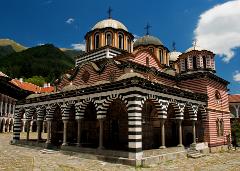Round-Trip From Sofia to the Northern Black Sea Coast

- Duration: 6 Days (approx.)
- Location: Sofia
- Product code: NORTHSEA
About
This tour takes you to the northern side of Bulgaria’s Black Sea coast, where some of the oldest towns and cities in Bulgaria are located. It starts from Varna, often called the maritime capital of Bulgaria – a city known for its beautiful Seaside Garden and centuries’ worth of history preserved in its museums, archeological digging sites, old churches and buildings. We’ll visit the Botanical Garden of Balchik, Cape Kaliakra with its ancient Thracian fortress, the Madara Horseman rock-relief (which is on the UNESCO World Heritage List) and 2 of Bulgaria’s former capitals – Pliska and Preslav. We’ll finish our round trip with a sightseeing tour of Sofia and its top attractions.
Highlights
• Go sightseeing in Bulgaria’s maritime capital – Varna
• Explore its gorgeous Seaside Garden
• Visit the Aladzha Rock-Monastery, built in the 12th century
• Travel to Balchik and tour its Botanical Garden
• See the Thracian fortress in Cape Kaliakra
• Visit Pliska, the first historical capital of Bulgaria, and tour its Old Town open-air museum
• See the Madara Horseman rock-relief – a UNESCO World Heritage Site
• Tour the archeological reserve of Preslav and its Round Golden Church
• See Sofia’s top attractions
Description
Day 1
Arrival at Sofia Airport. Overnight in Sofia.
Day 2
First thing in the morning after breakfast, we head for Varna – the maritime capital of Bulgaria and third largest city in the country. Those who wish may travel to Varna Airport by plane as an optional extra.
Its Seaside Garden is the largest in Varna and follows the Black Sea coastline. It is one of only 3 man-made natural reserves in Bulgaria, home to rare and endangered plant species. It is said that if one walks backwards over the bridge at the entrance of the main garden alley with their eyes closed and make a wish, that wish will come true. On its northern side is the Varna Dolphinarium, and on the southern side – the Varna Aquarium. The Varna Zoo and the Planetarium are also located within the garden’s bounds.
Located in the heart of Varna, the “Assumption of the Holy Mother of God” Cathedral is the largest Christian temple in Varna, and the second tallest in the country after Sofia’s St. Alexander Nevski. Its impressive size and external and internal architectural style make it one of Varna’s top attractions.
Among its many fascinating exhibits, the Varna Archeological Museum houses the oldest gold treasure in the world. Discovered in the Varna Necropolis, the jewelry dates back to 4600 BC.
Varna is home to the ruins of the largest Roman bath-house in the Balkans. The Roman Thermae date back to the 2nd century AD, and were once 20 meters tall, and the full structure used to cover an area of 7000 square meters.
Aladzha Monastery is an abandoned Medieval Orthodox Christian cave-monastery that dates back to the 12th century. The cambers, doorways and stairs are carved right into the rock.
Overnight in Varna.
Day 3
We’ll be transported from Varna to the town of Balchik. Queen Marie of Edinburgh famously fell in love with Balchik and built a summer residence there – a picturesque castle with its own Botanical Garden, home to rare plant species. We’ll go sightseeing in the Botanical Garden, specialized in growing tropical, subtropical and unique plant species. Particularly notable is its collection of large cacti and succulents, including winter-hardy cactuses. The garden’s collection includes tree species and lemon trees that bear fruit larger than coconuts, aquatic plants, vines, ferns and endangered plants, totaling 4600 species of plant. It is part of the Index Seminum Initiative, trading plant seeds with countries from all over the world.
We’ll next visit Cape Kaliakra – a nature and archeological reserve that stretches 2 km into the sea. It is as beautiful from afar as it is from up close – its reddish cliffs plunge almost vertically into the waves, and the sea itself is a stunning backdrop for an already picturesque landscape. Cape Kaliakra is reaches far enough into the sea that one can sometimes see dolphins from its cliffs. The first to settle on this cape were a tribe of Thracians in the 6th century BC. The fort wall they built around their settlement stands to this day, as do the remains of building foundations and an impressively intact tomb and a bathhouse dating back to the 4th century BC. We’ll walk to the farthest end of the cape and visit the chapel. After that we’ll sit down for lunch at the restaurant and head back to Varna.
Overnight in Varna.
Day 4
This day takes us to Pliska – the first ever Capital of Bulgaria. The remains of its Old Town are now an open-air museum and one of the best preserved archeological museums in Bulgaria.
Our next stop is Shumen. We’ll be visiting Tombul Mosque – the largest mosque in Bulgaria. Its support columns were once part of the castle of the first Bulgarian Khans. Shumen’s Founders of the Bulgarian State Architectural Complex is dedicated to the 1300th anniversary of the founding of Bulgaria in 681. This memorial complex depicts prominent Bulgarian monarchs and their contributions to the development of the country.
Our next stop is the Madara Horseman – an early medieval rock relief and UNESCO World Heritage Site. It was carved into the side of the cliff in the 7th century and depicts a horseman thrusting a spear at a lion before him, a dog running in his wake. The relief is 23 m above ground and the figures are almost full-sized. Its origin and meaning are unknown, some claiming that it represents a Bulgar deity, some relate it to the Thracian Horseman motif, while others say that it depicts the Bulgarian Khan Tervel.
We’ll then go to the Kabiyuk horse-ranch – the largest horse ranch on the Balkans. You’ll see the different horse breeds in the ranch, with optional horse-riding available on request.
Our tour also takes us to the second historical capital of Bulgaria – Preslav. Its architectural reserve features restored and reconstructed structural elements from the former city. A major attraction is the Round Golden Church – an early medieval architectural masterpiece, once richly decorated in carved marble, painted ceramics and glass mosaics. It owes its name to the gold coating that once adorned its dome. These ornaments have been lost to the ages, and the remains of the church now lie bare, but one can still enjoy the beautiful architecture and gain a sense of its former size and layout – some of its walls, columns, arches and other features remain to this day.
Adjacent to it is a museum showcasing 1500 artifacts, among which are the Preslav gold treasure, a ceramic iconostasis from the historical Dvortsov Monastery and other examples of the white ceramics typical of the Preslav area.
Overnight at a hotel near Pliska.
Day 5
We head for Sofia first thing in the morning after breakfast.
On this day, we’ll go on a sightseeing tour of Sofia’s top attractions. Its busy streets, the beautiful Baroque architecture in the Center and the park possess a lively charm that leaves you eager to explore, but the monuments and landmarks it is most famous for deserve our full attention.
The Saint Alexander Nevsky Cathedral is one of the largest Orthodox Christian cathedrals in the world and the second largest on the Balkan Peninsula. Its impressive size and intricate design mark it as one of the most stunning architectural marvels in Bulgaria and Sofia’s most recognizable landmark.
The Saint Sophia Basilica is a red-brick church is stands atop the foundations of a sacred temple built in Roman times. The huge burial site under its floor allows visitors of the church to explore its catacombs and get lost in a labyrinth of ancient tombs and corridors.
The Church of St. Nicholas the Miracle-Worker is a beautiful golden-domed church designed in the Russian Revival Style. Visually, it is unlike any other Orthodox church in Bulgaria. It is believed to be able to grant wishes.
The Ivan Vazov National Theatre is an example of neoclassical architecture is so spectacular that you will want to carry the memory home with you.
The Church of St. George, built by the Romans is in the 4th century, is an early Christian red brick rotunda that is considered the oldest building in Sofia.
The bustling Vitosha Shopping Street perfectly embodies the dynamic atmosphere of the capital of Bulgaria.
Overnight in Sofia.
Day 6
Departure from Sofia Airport.
The price includes
• 5 overnights in stylish hotels on half board
• Professional tour guide
• Minibus transfers
The price does not include
• Flight to/from Bulgaria
• Flight from Sofia Airport to Varna Airport: 100 € per person (optional)
• Flight from Varna Airport to Sofia Airport: 100 € per person (optional)
• Entry fees
Notes
This tour requires a minimum of 6 people.



